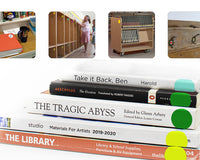Many book lovers love to collect old books, but how old is old? A hundred years? Five hundred? The answer becomes even blurrier when you consider that books have been around in many forms for much longer than people realize. Discover these amazing facts about the history of book binding and learn how to distinguish truly old books from more recent ones.
The Purpose of Book Binding
Before we dive into the history of book binding, it’s important to lay out just why people bind books in the first place. One obvious reason is that book covers help protect the book’s delicate pages from damage, but that’s not the only thing they do. Covers also help with identification of both the book and the person responsible for it.
Covers are also an important way for people to mark their ownership of books. Modern-day library books often have a sticker that shows which branch they belong to. Book lovers all across history have used book plates on the insides of covers to identify themselves as owners. Wealthy nobles from history used to get their books bound in matching covers, usually with their monogram on the binding.
Bindings also help hold books together and help us distinguish them from each other. Imagine how chaotic your bookshelf would be if you only had loose pages! Bindings keep everything secure in one place for easy reading and portability. They can even let you bind multiple books together (the fancy word for this is a sammelband).
The Ancient World
Before there were books as most modern people think of them, there were scrolls. Cultures like Ancient Greece used scrolls just like we use books now—for education, record-keeping, and leisure. In fact, their word for book was biblios, which means papyrus scroll.
So how did the ancients keep their books safe without traditional covers? Well, in some ways they didn’t succeed in doing so—let’s all shed a tear for the Great Library of Alexandria. Unfortunately, the ancients tended to stack their scrolls on shelves without much protection.
However, the Romans developed a scroll carrying-case called a capsa that they used to transport several scrolls at once. It was basically a big, cylindrical, leather and wood bag with a lid and carrying straps. Some Roman writers also mention wrapping their books (aka scrolls) in fabric sleeves when presenting them as gifts.
One amazing fact about the history of book binding is that, by the fifth and sixth centuries, codices largely replaced scrolls as the book format of choice. A codex is the ancestor of our modern books, with pages stacked between two covers and bound on one side.
Medieval Book Bindings
As codices spread with the rise of Christianity, the process of book-making and binding became more and more elaborate. However, many of these books ended up on the shelves of monasteries and nobles. It wasn’t until the latter half of the Middle Ages that regular, middle-class people started owning their own books—since the process was very expensive and labor-intensive.
A typical medieval book was handwritten on parchment, a type of writing surface made from animal skins. The monks who made the books would then sew the quires together and bind them in wooden boards covered in leather. These leather covers could be very ornate, depending on the client.
One of the most interesting research trends with old books has been the use of DNA sampling. Scientists have learned how animal populations changed the book manufacturing process by studying the kinds of animal parts used in the pages and bindings.
Early Modern Book Binding
People often mislabel Gutenberg as the inventor of the printing press, when he actually invented moveable type, the process that made printing presses so much more efficient than manuscript writing. Early printed books—called incunabula for being “in the cradle,” or infancy, of printing—had bindings much like their medieval counterparts.
The reason for this was that manuscripts still dominated the book landscape for at least the first hundred years or so of printing. People wanted their books to look like they had for the last several thousand years—so printers designed their books to mimic the large, handwritten books and Bibles people were used to.
However, the Protestant Reformation sped up the process of book development, and over the course of the fifteenth and sixteenth centuries, things changed rapidly. Book-makers developed new techniques, and the tasks of printing and binding books became separate industries.
In fact, you could buy copies of Shakespeare’s plays with nothing more than paper covers on the outside. To get your books bound, you’d have to take them from the print shop to a book-binder. This is how people with large libraries managed to get all their books to have the same cover.
For wealthy book lovers, it was a golden age of binding design. Binders used expensive leathers, vellum, and rich fabrics to create luxury copies for their upscale clients. They even used materials such as gold tooling to further decorate the covers. Marbled papers became common in books as endpapers, the decorative sheets masking the unfinished side of the leather covers.
Industrial and Modern Book Binding
Not much changed in book-binding technology until the nineteenth century, with the advent of industrialization. Publishers assumed nearly all the duties of book production, and they sold books with their covers already attached. While they weren’t exactly cheap, they were much more affordable than ever before—and became even more so as the century went on.
Today, computers have made the process of mechanized printing even easier. Cheap paperback copies typically have glue and paper bindings, but you can still spend lots of money on nicer editions of your favorite books. In fact, it’s become popular again to offer higher quality bindings to everyday book lovers—such as the Barnes & Noble and Penguin hardcover classics.
Rebinding Made Easy
If your books are starting to fall apart, it can be tempting to replace them. Unfortunately, that could mean losing all your notes—plus the nostalgia of having your favorite, well-loved copies.
A better idea is to simply rebind them using ChromaLabel’s book mending tape. The process is super easy, and ChromaLabel has a variety of cloth and clear tapes in different sizes to help you find the right option. Call or email us today if you have questions about your book-binding project!










